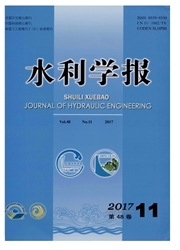

 中文摘要:
中文摘要:
洪水事件一般由洪峰与时段洪量等多个要素组成,各要素间通常存在较强的正相关性,应进行多变量联合分析。在进行多变量洪水频率分析时,对于给定的联合重现期水平,存在满足防洪标准的无穷多种峰、量组合,但并非所有的组合都符合水文事件的内在规律,只有在一定的范围内取值才是合理的。本文基于Copula函数构造洪水峰、量之间的二维联合分布,提出了一种确定两变量取值边界的方法,推导了两种具有统计意义的两变量联合设计值组合,即两变量同频率组合和条件期望组合。以清江流域隔河岩水库为应用实例,结果表明,两变量设计值组合对应的水库调洪最高水位高于单变量设计值,但差别不大,从防洪安全的角度考虑,推荐采用两变量同频率组合作为水库防洪设计值。所提方法拓展了多变量洪水频率分析技术在水利工程实际中的应用范围。
 英文摘要:
英文摘要:
Flood event consists of flood peak and flood volume that are mutually correlated and need to be described by multivariate joint distribution. In the multivariate case, the choice for design flood for an appropriate return period leads to the infinite combinations of flood peak and flood volume that satisfy the flood prevention standard. However, not all the combinations are reasonable in hydrology so that a bound- ary for selection of flood peak and volume is needed. In this paper, the bivariate joint distribution of flood peak and volume is constructed by copula function. A methodology is proposed to identify the boundary for selecting bivariate combinations of flood peak and volume. Two statistically-based combinations of flood peak and volume, i.e. bivariate equivalent frequency combination and bivariate conditional expectation combi- nation are derived with a given return period. The application results of Geheyan reservoir located at the Qingjiang River show that the highest water levels of bivariate flood combinations are slightly larger than that of univariate design flood. As a result, the bivariate equivalent frequency combination is suggested as the design flood for the safety of reservoirs. The proposed boundary identification and combination selection methods expand the application range of multivariate flood frequency analysis technique in hydrological engi- neering.
 同期刊论文项目
同期刊论文项目
 同项目期刊论文
同项目期刊论文
 期刊信息
期刊信息
